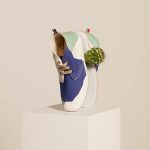 Gabon became aware of its exceptional heritage very early on and undertook a vast conservation programme to preserve its forests, flora and fauna, anticipating the goals of the 3rd millennium back in 1972.
Gabon became aware of its exceptional heritage very early on and undertook a vast conservation programme to preserve its forests, flora and fauna, anticipating the goals of the 3rd millennium back in 1972.
Instigated by the late President of the Republic, El Hadj Omar Bongo Ondimba, this action in favour of the environment is an integral part of the new Project for Society of the new President, His Excellency Ali Bongo Ondimba: this policy is only possible if we can reconcile local, economic and development interests. The concept of ecotourism will be the tourism of the future. It constitutes the cornerstone of “Green Gabon”, one of the three pillars of emerging Gabon. We are also determined to play an active part in meeting the goals of the 3rd Millennium, particularly by continuing to implement the Climate Plan’s.
About Eco-Tourism contributes to the conservation of biodiversity and sustains the well-being of local people, while providing guests with a learning experience and requiring the lowest possible consumption of non-renewable resources. The message is proactive, going beyond simple minimising the negative impact of tourist activities but recognising that tourism can be a powerful force for good. The emphasis is on community participation, both as agents of conservation and so that people can enjoy improved living standards.
Although modern facilities are often not available, so having an adventurous spirit, keeping an open mind, and being willing to exercise understanding and patience will assure a visitor of a wonderful experience during his visit. Gabon is a peaceful land and one of the safest of all Central and Western African countries, thereby providing save traveling opportunities. Local tour operators can arrange visits to all the major places of interest.
Gabon is an environment treasure. Approximately 20 percent of plant species in Gabon are exclusive, and they can`t be found anywhere else in the world. In the heart of Africa, crossed by the Equator, Gabon is the perfect link between equatorial jungle and the Atlantic Ocean. Waters full of fish, deserted beaches, and cool winds softening the hot savannah and Jungle. The primary humid and luxurious jungle accounts for 85 per cent of a wide green land inhabited by elephants, buffaloes, monkeys, gorillas, antelopes and many more. The Ogooue river, its immense hydrographic network, turbulent waters running from East to West sustaining the country’s human as well as economic activity. Gabon is the least densely populated country in Central Africa; it has the largest section of undisturbed rainforest on the continent, covering more than 85 per cent of the country. Its natural assets include mighty rivers with magnificent waterfall and vast untouched beaches where dolphins, humpback whales and leather back turtles cavort offshore.
The country also has a remarkable archaeological heritage. The oldest multi cellular fossil in the world (2.1 billion years) was found in the Plateaux Bateke region. The first humans appeared 400,000 years ago, and the oldest tools used by humanity were found in the Lope National Park. One can go into the equatorial jungle in search for the mysterious Pygmies and the famous gorillas. And can also enjoy sailing in a dugout along the Ogooue river and its tributaries full of mangroves, small islands, lakes, waterfalls and canyons. But if a person prefers game fishing, swordfish, tuna fish, tarpons and bonitos can all be found in deep waters. Excellent spots for surfing and water sports such as waterfalls and rapids offer you unforgettable moments. Gabon, country of arts, has a rich and unsuspected culture. This culture is expressed by its craft industry, dances, rites and lifestyle.
National Parks and Reserves of Gabon In the region of Libreville, the Akanda National Park is a 540 km² mangrove just a few minutes away from the capital with an extraordinary variety of wildlife. The Pongara National Park, less than an hour away by boat, is home to a very rich variety of fauna, particularly buffaloes, elephants and the damara tern, a threatened species. Here you can observe 550 leatherback turtles lay their eggs and the incredible spectacle of the mudskippers, amphibian fish that hunt insects out of the water! The Monts de Cristal National Park consists of uplands that are difficult to access. Its climate is perfectly adapted to plants that thrive in humid conditions, like orchids and begonia. Botanists estimate that it hosts the richest plant biodiversity in all of Africa.
Along the Congolese border, few parks remain relatively unexplored like the Plateaux Bateke National Park: an ocean of grassland in the heart of the equatorial forest, in the kingdom of the Tee, a Bantu people. In places, the gentle landscape is broken by spectacular multicoloured pink, orange and black cliffs. There are also many archaeological vestiges. To get there, you have to cross a liana bridge and the Ndobi falls: a real adventure! New installations will soon enable visitors to observe the gorillas in the Howletts Foundation.
The Mwagna National Park with its bai (clearing) that is sacred to the pygmies attracts forest elephants, monkeys, forest hogs, bongo antelopes, sitatungas and duikers. There are still many discoveries to be made there. Legend tells of a giant dinosaur like creature, the moke mbembe. Finally, to the North, the Minkebe National Park is an immense 8,000 km2 virgin forest with the largest concentration of elephants in the Congo Basin (an estimated 30,000 individuals) and rare species like the very shy bongo antelope.
Central Gabon has the most interesting sites in Africa for observing long-nosed crocodiles (in the Ivindo National Park) and mandrills (the largest population is to be found at Lope, where a research centre is dedicated to them). The Lope National Park has been on the UNESCO World Heritage list since 2007. This park offers two except ional experiences: a night in the heart of the Gabonese savannah observing antelopes and duikers, bush pigs, savannah birds and an initiation to the Ndjembe secret society. Sheltered by the Chaillu massif, the Waka Park remains relatively unknown. The everyday lives of the people here are punctuated by their traditions and spiritual culture. Their vast knowledge regularly enables them to assist conservation specialists working in natural sites.
In the future, their knowledge and respect for nature will make them indispensable Eco guides. Finally, the sun-tailed monkey, a primate previously unknown to science, was discovered in 1984 in the Birougou National Park in the centre of the Chaillu massif. Along the coast, the Loango National Park is an extraordinary and complex patchwork of beaches, lagoons, mangroves, salt meadows, swamps, savannah and forests. Elephants, hippopotamuses and hump-backed whales share the pleasure of the rolling waves and the deserted beaches here. This is the finest site in tropical Africa for recreational fishing both in the sea and in lagoons. The Mayumba National Park is one of the most important laying sites in the world for the leatherback turtle. Now an endangered species, the park was created to protect them. Here you can see surfing hippopotamuses. The Moukalaba-Doudou National Park comprises mountain rainforests, some of the driest savannah in the country, lakes, rivers and papyrus groves. It has one of the highest densities of primates in Gabon.








